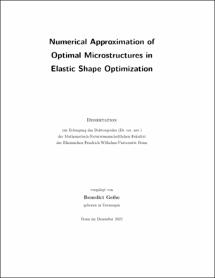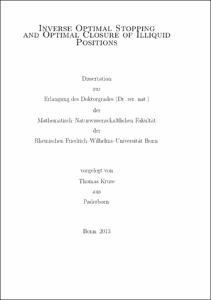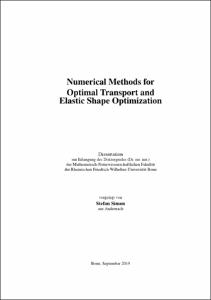Numerical Approximation of Optimal Microstructures in Elastic Shape Optimization

Numerical Approximation of Optimal Microstructures in Elastic Shape Optimization

| dc.contributor.advisor | Rumpf, Martin | |
| dc.contributor.author | Geihe, Benedict | |
| dc.date.accessioned | 2023-06-15T12:58:10Z | |
| dc.date.available | 2023-06-15T12:58:10Z | |
| dc.date.issued | 15.06.2023 | |
| dc.identifier.uri | https://hdl.handle.net/20.500.11811/10890 | |
| dc.description.abstract | We develop and analyze a numerical two-scale optimization scheme for structural shape optimization. Whenever cost functionals, such as the elastic energy, are subject to minimization, while meeting a constraint on the available material, the emergence of microstructures can be observed. The costs are constantly reduced by fine-scale structures on a decreasing length scale δ. For an optimum, a generalized notion is required in the limiting case δ → 0, where materials are macroscopically characterized by an effective density θ ∈ [0, 1] and an effective behavior only. These are governed by the concrete realization of the underlying microstructure and there are provable optimal, yet nonunique, constructions. Being mostly of theoretical interest, they lack a physical counterpart, which could serve as guidance for manufacturing real materials. The goal of this work is to establish a flexible algorithmic method, that can assess the approximation quality of alternative, simple microstructure models.
A numerical simulation and optimization can only be computationally feasible when distinct length scales are treated in a coupled but separated manner. This work builds upon the intuitive idea of pointwise probing the reaction of the underlying microstructure. A linearization of the macroscopic displacement serves as an affine-periodic boundary condition for a locally attached cell problem, whose solution is used as the microscopic correction. The intuitive approach is rigorously derived and linked to well-known concepts of homogenization, two-scale convergence and the heterogeneous multiscale method (HMM). This allows to adopt results on the approximation quality of the two-scale approach and its discretization. The deformation of the elastic bodies is modeled via the partial differential equations of linearized elasticity. Within the microscopic cells, the shapes of perforations, parametrized by few degrees of freedom, will be subject to optimization. For this purpose, the shape derivative will be computed analytically in the two-scale context via an adjoint approach. Upon discretization, a finite dimensional optimization problem with constraints on the microscopic geometries and the globally available amount of material is achieved. The numerical scheme uses a finite element discretization on the macroscale and a boundary element method on the microscale. For the optimization problem, an SQP-algorithm of the software Ipopt is employed. At first we consider synthetic problems that allow to study the behavior of optimized microstructures and identify their limits with respect to optimality. On the basis of classical shape optimization problems, we then compare various microstructures among each other and study the gap towards optimality, realized by the analytically optimal sequential lamination model. Furthermore we discuss the influence of numerical parameters and algorithmic speed-up measures. Next the two-scale scheme is applied to problems in risk averse stochastic optimization, where multiple loads with different probabilities of occurrence need to be taken into account in an appropriate manner. In view of the appearing highly nonlinear functionals, the scheme proves to be robust. Furthermore the concept of stochastic dominance is introduced, which allows to compare results with single-scale optimized shapes. Finally we derive a posteriori error estimates for the two-scale scheme, following the dual weighted residual (DWR) approach. They are employed to adaptively refine the macroscopic computational grid, which allows to achieve results comparable to uniform refinement with drastically reduced computational cost. The adaptive scheme is used both with the analytical sequential lamination model and the numerical two-scale approach. Furthermore an error estimator is developed, which allows to locally assess the modeling error of the simple microstructures with respect to optimal materials. | en |
| dc.description.abstract | Numerische Approximation optimaler Mikrostrukturen in der elastischen Formoptimierung Zur strukturellen Formoptimierung wird ein zweiskaliges numerisches Optimierungsverfahren entwickelt und analysiert. Bei der Optimierung unter Einhaltung einer beschränkten Materialmenge kommt es zur Entstehung von Mikrostrukturen auf einer kleiner werdenden Längenskala δ. Für ein Optimum müssen verallgemeinerte Materialien zugelassen werden, die im Grenzfall δ → 0 makroskopisch durch eine Dichte θ ∈ [0, 1] und ein effektives Materialverhalten bestimmt sind. Dieses wird durch die Mikrostruktur festgelegt und es existieren beweisbar optimale, wenn auch nicht eindeutige, Konstruktionen. Meist sind jene von rein theoretischem Interesse und können nicht als Vorbild für einen realen Fertigungsprozess dienen. Das Ziel dieser Arbeit ist es, ein flexibles algorithmisches Verfahren zu entwickeln, das alternative, einfach geartete Mikrostrukturen analysieren kann. Für eine effektive Simulation und Optimierung müssen unterschiedliche Skalen separiert, aber dennoch gekoppelt, behandelt werden. Der Ansatz dieser Arbeit fußt auf der Idee, das Reaktionsverhalten der Mikrostruktur zu sondieren. Hierbei wird die makroskopische Deformation durch die Lösung eines lokalen Zellproblems korrigiert. Der Ansatz wird rigoros hergeleitet und in bekannte Konzepte der Homogenisierung, Zweiskalen-Konvergenz und heterogenen Multiskalen-Methode (HMM) eingebettet. Die elastische Deformation wird durch die partiellen Differentialgleichungen der linearisierten Elastizität modelliert. Optimiert werden parametrisierte Perforationen in den mikroskopischen Zellen. Hierzu wird die Formableitung analytisch über einen dualen Ansatz bestimmt. Nach Diskretisierung entsteht ein endlichdimensionales Optimierungsproblem unter Nebenbedingungen. Das numerische Verfahren verwendet finite Elemente auf der Makroebene und Randelemente auf der Mikroebene. Synthetische Optimierungsprobleme zeigen die Grenzen hinsichtlich der Optimalität der eingesetzten Mikrostrukturen auf. Anhand von klassischen Szenarien werden die Modelle untereinander und mit dem analytisch optimalen Modell der geschachtelten Laminate verglichen. Das Verfahren wird zudem auf Probleme der stochastischen Optimierung angewandt, wo verschiedene Lasten mit entsprechenden Wahrscheinlichkeiten in geeigneter Weise berücksichtigt werden müssen. Des Weiteren wird mit dem Konzept der stochastischen Dominanz ein Vergleich mit optimierten einskaligen Resultaten ermöglicht. Schließlich werden nach dem Konzept der dual gewichteten Residuen (DWR) a posteriori Fehlerschätzer hergeleitet, die eine adaptive makroskopische Gitterverfeinerung ermöglichen und zu gleichwertigen Ergebnissen bei deutlicher geringerer Rechenzeit führen. Das Verfahren wird sowohl für geschachtelten Laminate als auch für das numerische Zweiskalen-Modell eingesetzt, wodurch Aussagen zum Modellierungsfehler hinsichtlich optimaler Materialien gewonnen werden. | en |
| dc.language.iso | eng | |
| dc.rights | Namensnennung 4.0 International | |
| dc.rights.uri | http://creativecommons.org/licenses/by/4.0/ | |
| dc.subject | Formoptimierung | |
| dc.subject | Optimierung | |
| dc.subject | Numerische Simulation | |
| dc.subject | Deformation | |
| dc.subject | Elastizität | |
| dc.subject | Mikrostrukturen | |
| dc.subject | Homogenisierung | |
| dc.subject | Zellproblem | |
| dc.subject | Multiskalen | |
| dc.subject | Zweiskalen | |
| dc.subject | Heterogene Multiskalenmethode (HMM) | |
| dc.subject | Geschachtelte Laminate | |
| dc.subject | Relaxierung | |
| dc.subject | Stochastische Optimierung | |
| dc.subject | Stochastische Dominanz | |
| dc.subject | Finite Elemente Methode | |
| dc.subject | Randelementmethode | |
| dc.subject | Adaptivität | |
| dc.subject | A posteriori Fehlerschätzer | |
| dc.subject | Dual gewichtete Residuen (DWR) | |
| dc.subject | Modellierungsfehler | |
| dc.subject | Shape optimization | |
| dc.subject | Optimization | |
| dc.subject | Numerical Simulation | |
| dc.subject | Deformation | |
| dc.subject | Elasticity | |
| dc.subject | Microstructures | |
| dc.subject | Homogenization | |
| dc.subject | Cell problem | |
| dc.subject | Multiscale | |
| dc.subject | Two-scale | |
| dc.subject | Heterogeneous multiscale method (HMM) | |
| dc.subject | Sequential lamination | |
| dc.subject | Relaxation | |
| dc.subject | Stochastic optimization | |
| dc.subject | Stochastic dominance | |
| dc.subject | Finite element method | |
| dc.subject | Boundary element method | |
| dc.subject | Adaptivity | |
| dc.subject | A posteriori error estimate | |
| dc.subject | Dual weighted residual approach (DWR) | |
| dc.subject | Modelling error | |
| dc.subject.ddc | 510 Mathematik | |
| dc.title | Numerical Approximation of Optimal Microstructures in Elastic Shape Optimization | |
| dc.type | Dissertation oder Habilitation | |
| dc.publisher.name | Universitäts- und Landesbibliothek Bonn | |
| dc.publisher.location | Bonn | |
| dc.rights.accessRights | openAccess | |
| dc.identifier.urn | https://nbn-resolving.org/urn:nbn:de:hbz:5-70818 | |
| dc.relation.doi | https://doi.org/10.1051/m2an/2017004 | |
| dc.relation.doi | https://doi.org/10.3934/dcdss.2016055 | |
| dc.relation.doi | https://doi.org/10.1007/978-3-319-05083-6_13 | |
| dc.relation.doi | https://doi.org/10.1007/s10107-012-0531-1 | |
| ulbbn.pubtype | Erstveröffentlichung | |
| ulbbnediss.affiliation.name | Rheinische Friedrich-Wilhelms-Universität Bonn | |
| ulbbnediss.affiliation.location | Bonn | |
| ulbbnediss.thesis.level | Dissertation | |
| ulbbnediss.dissID | 7081 | |
| ulbbnediss.date.accepted | 02.05.2023 | |
| ulbbnediss.institute | Mathematisch-Naturwissenschaftliche Fakultät : Fachgruppe Mathematik / Institut für Numerische Simulation (INS) | |
| ulbbnediss.fakultaet | Mathematisch-Naturwissenschaftliche Fakultät | |
| dc.contributor.coReferee | Conti, Sergio | |
| ulbbnediss.contributor.orcid | https://orcid.org/0000-0002-9519-6872 |
Dateien zu dieser Ressource
Das Dokument erscheint in:
-
E-Dissertationen (4413)







